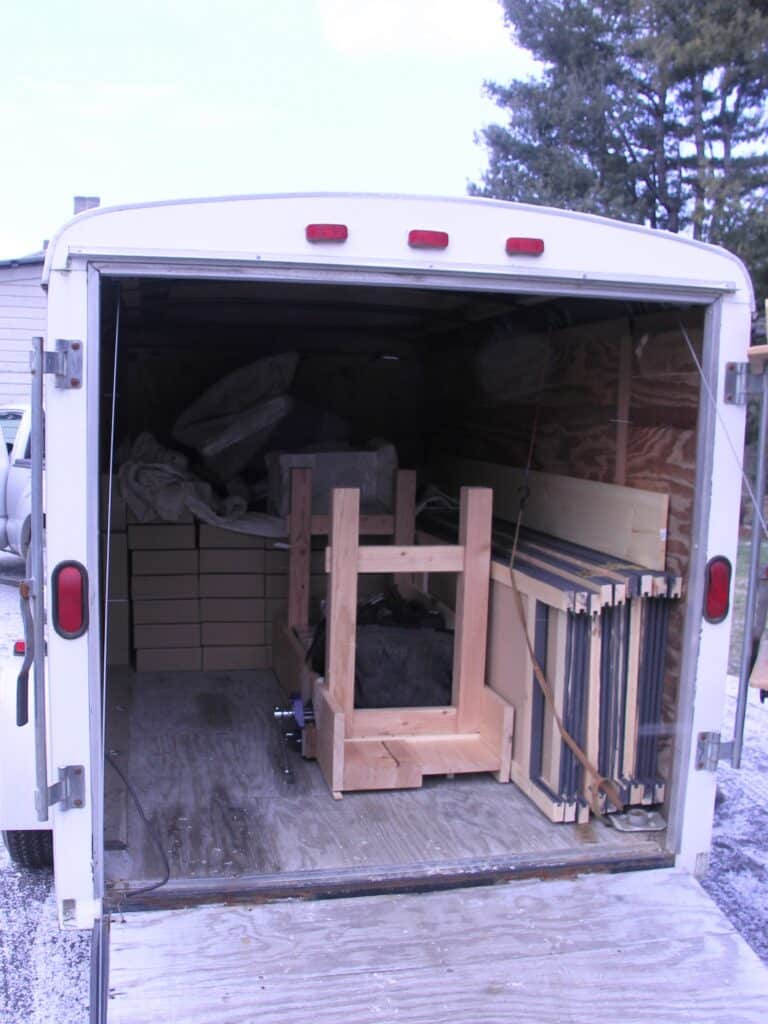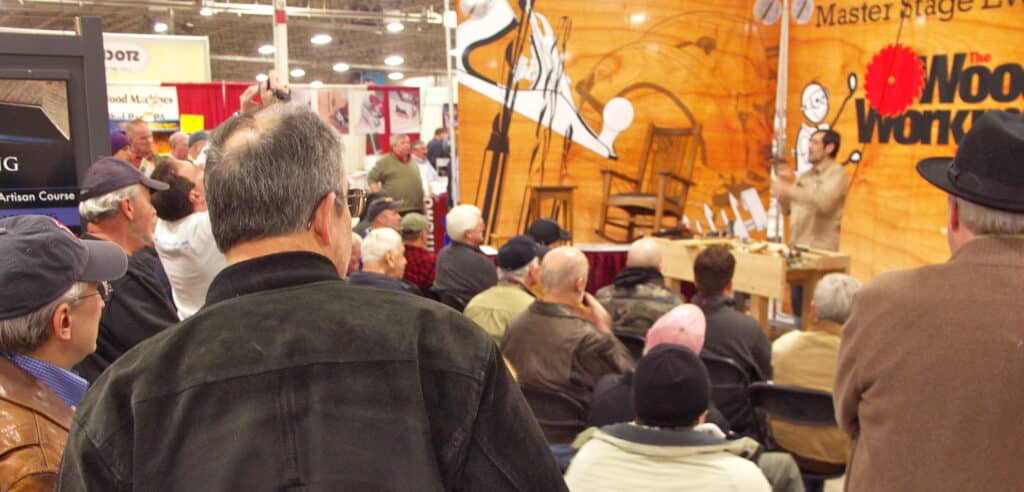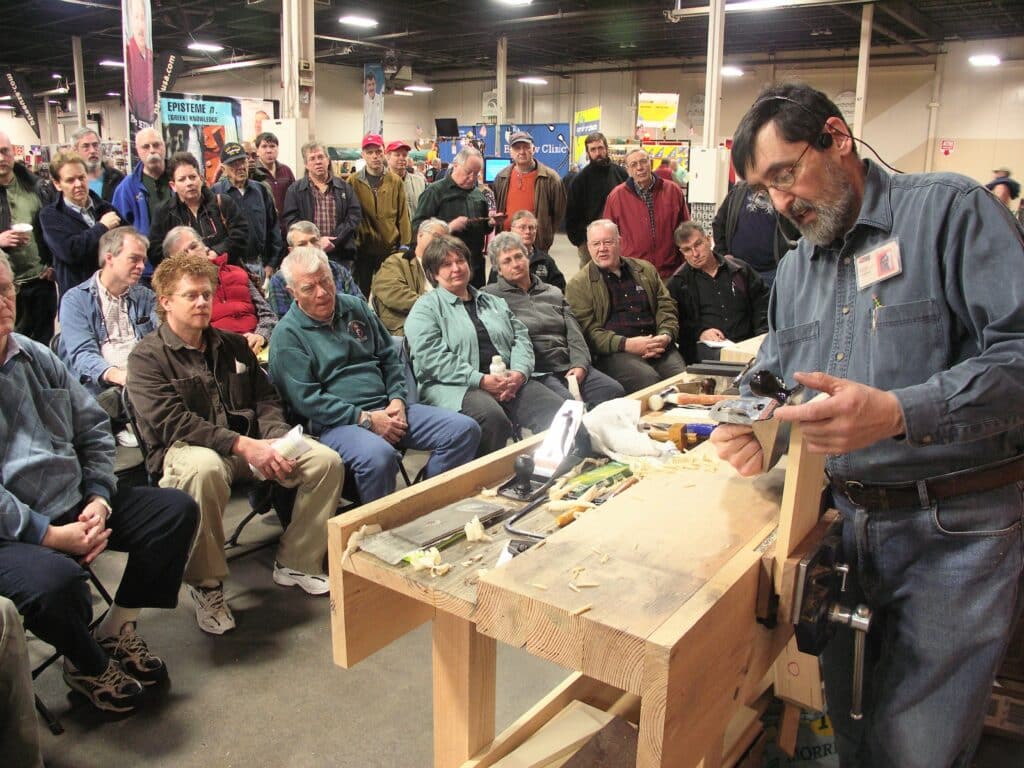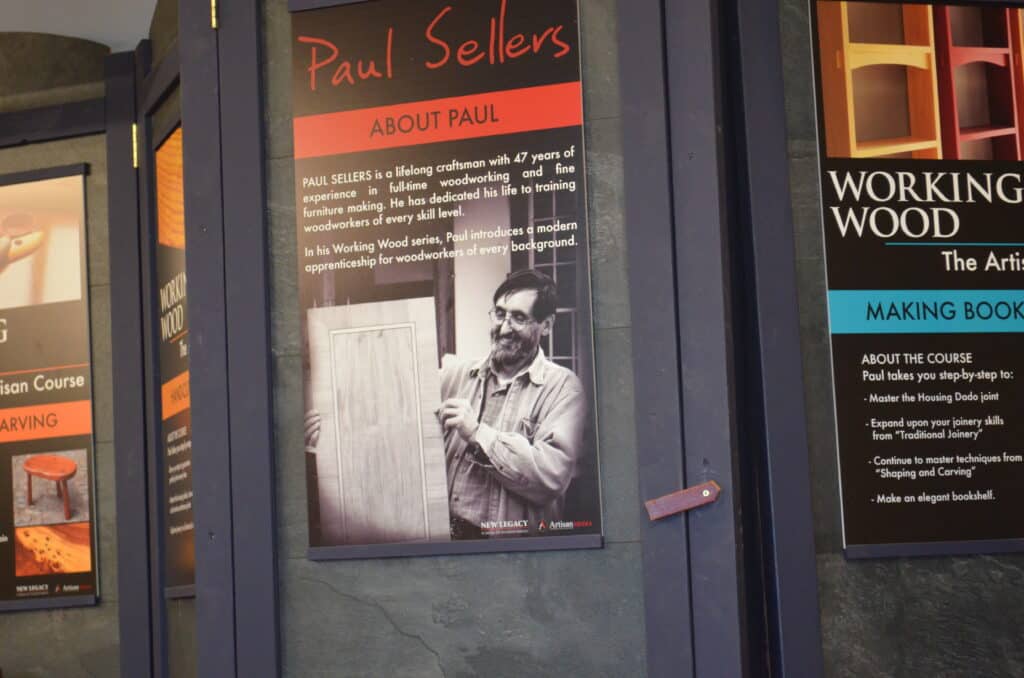It Was Just a Dream . . .
. . . Or Was It a Vision

The day was just about starting with the usual hint of the bright sunshine Texas is known for. I’d loaded the U-Haul box trailer with my display panels and furniture pieces to drive to the small town called Mesquite, Texas the night before. Mesquite’s only fifteen miles from Dallas so it’s near enough to have the benefit of big city crowd support without the hassle of big city prices, travel and parking, etc. My trip is short enough… about an hour and a half. Just over 100 Texas miles. There’ll be no traffic to speak of in the next hour. It’ll take me four hours to set up so I’m in good step to be done by noon, have a decent lunch and watch the early birds crowd the entrance for a worm of a bargain. This show is important to me. It’s 1995 and the first show for me to promote myself as a woodworking instructor promoting hand tool methods of woodworking to the woodworking world. Im excited by all the mixed feelings any new enterprise gives to anyone, but I’m confident even though I am going into a new gladiator arena with the big boys of woodworking.

It’s really a straight shot for me as I travel the frontage road and down the slip road onto the interstate. The sunrise behind me is a good sign even though its still just about winter. I’ve put so much work into creating the display over the past few weeks and then getting leaflets together explaining why I’m doing what i am doing. I realise i am smiling to myself as I travel. Who can tell what to expect. My display is 30 feet long and ten feet deep. The backdrop panels are different to every other at the show. There’s a solidity to them that speaks a different story. That’s what I wanted. Included in my display is a joiner’s workbench made from pine and a hand made box of hand tools. As I lay out the tools on the bench people seem halted beyond reason. It’s as if everything suddenly went into slo-mo mode where the strides seem elongated as they pass me. Some do a double take. Instead of walls of black, red, yellow and green walls of drill/drivers and power routers, skillsaws, boxes of screws, air-nailers and so on, here in my area they see rocking chairs and tables, backdrops of beautiful signs mounted of panels and explanations about how they can attend a course with me and learn the basics of hand tools in a matter of days. The show will start at two and my first demonstration will be at 3 PM. I’m ready. I had a good lunch, the tools are laid out and already my booth is crowded out. I have a hundred chairs in front of my bench and those most interested have taken the front two rows of premium seats.

“Welcome to the Deindustrial Revolution!” I say. I’m miked-up right from the start but for one reason only, the machines are going from wall to wall and then too everyone else is miked-up for the hype of selling. The ‘opposition’ is here for one reason only, they have to sell and and sell lots of what they have. With every booth selling pretty much the same gear, the scream of power routers, air nailers, power planers and all else under the machining sun is loud. But my message is important… more important. My story is different. I’m about to talk about a way of life as a woodworkers working only with hand tools. It’s a sort of quietly spoken word but it speaks loudly to those who have ears to hear. In many ways it seems to be much more impactful this way and that’s beacause out 200 or so booths at the show I am the only one. It’s the contrast I need and it’s hard not at all hard to stand out even in the crowded aisles. Could this be what all of these men and a handful of women have been looking for all along? Could this have been what they had been looking for but didn’t even know it? Didn’t know it existed even? Even my ripping through wood with a handsaw speaks louder than the thousand machines that switched on an hour ago. It will go until seven yet it could not drown out the simplicity of a tenon saw cutting a dovetail in a couple of minutes.

An audience makes a huge impact. they sit with me for forty minutes and then they won’t leave their seats as they fire questions from all sides There are challenges being in an environment with pockets of hostility. The few there that take offence with my message seem intent to say things that might matter only to them. They’re not looking for what I offer yet they insist on sitting thare and taking up the seats that might better suit the ones who can’t get one. I can always diffuse the antogonists in a quick second with a very effective split-second demonstration. Cain’t bet a random orbit sander though. I swipe off two shaving on a two foot length of oak three inches wide in a few seconds and pass it round. Twenty people run their fingertips over it and the other hundred around watch the smiles spread across their faces as they pass it on. Of course, it’s not apples for apples. And I do use random orbit sanders too. But that’s not why I am there. There is no competition for what I am offering.

So what am I offering? In many ways I began to see how a sort of dormancy had taken over the reasoning behind why so many started on their woodworking journey. They had become blind to the skills I just took for granted. My simple double dovetail joint levelled and smoothed to perfection with a very ordinary #4 Stanley somehow took of the blinkers (blinders USA) and this was the first time any of them had actually seen someone cut a dovetail joint with half a dozen basic hand tools.
The show owner, I’ve forgotten his name, stopped by the booth to inspect things on the last afternoon of the show, meandered through the exhibit and came to the bench. “This is a class act!” He said. From here on I’ll give you free booth space if you’ll just keep doing what you did this weekend. I never paid for a booth again. My three-booth set up would have cost me $1,500 or so. It was a lot for me in those days. I took him up on the offer and from that alone I filled my classes year round.
https://woodworkingmasterclasses.com/dashboard/
Common woodworking is another option. Here is that link too. This caters to anyone wanting to understand the basics so that they can launch off into deeper woodworking as a preset for developing the full mastery we promote through my blog and woodworking masterclasses. Additionally, for the past three years we have been building a houseful of hand made furniture. To do this we bought a house, emptied it, restructured the inside to bring everything up to date and then we built the furniture you might want for your home. Go to www.sellershome.com to catch up.
I’d be surprised if we don’t reach a million people every month online now with the same message I started out with back in my first class which was in 1990. The message and the methods have never changed simply because they couldn’t be improved on and the message remains the same. Did you know that back then the message spoke of how with around ten hand tools and three woodworking joints cut by hand you can make almost anything from wood. Join me above for ongoing opportunities to learn new skills you might never have believed possible. We will never bombard you but will occasionally nudge you to try some new thing I’ve come up with. I want you to have all the skills I have used over the last sixty years as a full-time maker. You will be proof of the efficacy of what I started in my first lessons 40 years ago when I started teaching kids classes for the local community. Nothing’s changed. Why? It didn’t need to.


I remember meeting Paul at one of the Woodworking Shows in New Jersey many years ago. Most woodworking I do with hand tools. I still use my 10 inch Rikon bandsaw, and very occasionally a very old Delta 8 inch table saw which belonged to a friend’s grandfather.
Thanks Paul
Thanks Paul. How long did it take for you to realize there was pent up interest in hand tools and learning how to use them?
Oh, if you poke around YouTube enough, I have seen at least one video of you from those days promoting your hand tool class. You cut a dovetail joint in about two minutes (can’t recall your exact slogan). You used a coping saw to get to baseline and no chisel. You free cut the tails. I really think it would be worth you putting out a silent modern YouTube video (maybe a short one) showing you do that. It would be a strong message. Not that I need to hear it or see it; you already have me.
The gods of traditional woodworking surely are pleased. I hope you can be sure that your efforts are remunerated with every moment we spend at our benches. From now until we feed the worms. Phenomenal work Paul. Thank you.
You changed my path in woodworking at a northeast show. I was a power tool only guy looking for that magical solution to make things when I stopped at your booth to rest.
Thank you for your sharing of knowledge and teaching ability.
Can I ask a question? I’m having trouble adjusting my hand plane. It stops shaving the wood and just burnishes the wood surface rather than cut into and shave it. No matter how I adjust the blade, it almost completely closes the opening for the shavings to go through, but it still refuses to cut. What am I doing wrong? Please advise.
Check to make sure the screws holding the frog are properly tight.
Is your blade really sharp? Are shavings getting trapped below the blade? Is the blade bevel correct?
The most common cause is installing the blade upside down so the bevel is uppermost rather than facing down. second cause would be the blade bevel is the wrong angle: should be between 25 and 34º. Within this range it will always cut. Third might be that the frog is too far forward.
I was going to bet on the edge angle being a bit on steep side. That’s exactly what I did wrong and, as sharp as the iron was, it just polished the wood.
Incidentally it was Paul’s video that showed me my error, although I still don’t have the skill to do it freehand but a Stanley honing guide (cost me £2 on a popular auction site) keeps me right.
Now I aim for 30 degrees and my planes are a pleasure to use.
Hope you resolve it happily Eric 😁
Yep, plane angle would be the best bet. A good way to check is to insert the blade and bring it forward until it touches the wood. Move the plane to it’s hanging over the side of your workpiece and then hold the plane steady(ish) and look under it. If you can see that the tip of the blade is touching the wood then it isn’t the angle, but if you see that the camber of the blade is touching the wood’s surface first then your angle is incorrect.
The second thing I’ve had before is that I’ve tried to get the cap iron very close to the edge of the blade (which is a good thing for smoothing), but I’ve nudged it when securing it to the blade, and the cap iron is actually overshooting the blade and making contact with the wood first rather than the blade. It’s a bit of a silly mistake, but it confused me for a good few minutes, as I kept advancing the blade and wondering why nothing was happening!
You could use a sharpie to blacken the bevel, then take a few passes with the plane. If the black wears away anywhere other than right near the edge, then the bevel angle is the problem.
That was me! Blade installed upside down.
Oh, how I perspired for hours and days trying to get a bevel-down plane to cut bevel up, as I sought to plane my Paul Sellers-designed bench-top made of glued-up pine two-by-fours. I was brand new to hand tools, thought you could tune a plane with a tuning fork, and installed my new, first plane blade (sharped just as Paul instructed) upside down. After first trying everything else, I was convinced it was inferior American trees that were my planing problem that refused to produce a shaving. About the tenth time through as I watched a “how-to” Paul video regarding plane setup, the very first words were: “Most bench planes are bevel down.” (PAUSE TV.) Back to my work room. Sure enough, upside down! Lol!
In addition to what Paul said.
Pay attention not to round over the tip of the edge of the cutting iron. (especially while stropping)
Otherwise you might end up without a relief angle even if the sharpening angle seems correct.
Without a relief angle at the tip of the edge, the iron will not engage in the wood and the plane will skate on the wood.
Two possibilities:
1. The frog is too far forward and the blade is creating too small a mouth for shavings the pass. This would be exacerbated by a chipbreaker that was also close to the leading edge of the blade.
2. If the plane’s sole has a hollow over the mouth, the blade will not reach the wood. In such a case, flatten the sole.
Regards from Perth
Derek
Two things. Is your plane supposed to operate bevel up, or bevel down? Most common Stanleys and similar are bevel down. Also, is the sole of your plane flat front to back? Burnished wood sounds like there is no engagement of the edge at all.
Have you made sure there is absolutey no gap between the blade and the cap iron? If there is any gap, shavings will be forced up between the two until the plane will not cut; and all you’ll end up doing is burnish the wood. Have a look. Good luck 👍
It’s sorted, Chris. My first suggestion was the blade being installed upside down. I was right!
When mine does that I sharpen the blade and that solves it for me.
Thank you Paul for your prompt response. I’ll see to the things you advised.
That is a happy video. It exemplifies the joy of woodworking.
Hi Paul,
I saw you at one of the shows here in TX about 15-17 years ago. It was a class act indeed. Thanks for helping to keep the skills going.
All the best, Dan Miller. Burnet TX.
BRAVO, master Sellers! A moving blog entry. I got something in my eyes while reading it. 😉
Thank you Paul for all the information you freely share with us. I have learned so much from your videos. Keep up the amazing work you do! 👍
Me too…
I, too, found your presentation at the woodworking show about 10 years ago. I bought your book and the DVDs and it changed my life. Class Act, indeed. Thanks.
I had a full shop of power tools but I knew something was missing. So I’d go to woodworking shows to see what was out there. That’s where I saw Paul for the first time.
It was in New Jersey that I saw Paul demonstrating sharpening a chisel, using a hand saw, and planing a piece of wood. That’s what was missing.
So I went home and sold all my power tools and bought old handbooks from eBay.
Took a while but I learned to make dovetails, mortis and tenon joints, raised panel doors, draws and even a workbench.
I love it all. I’m content. I’m happy.
Thanks Paul.
I believe I first met Paul at either the Mesquite or Arlington Woodworking Show next door to the new Cowboys Stadium in the mid-late ’90s. I recall he had his bench set up on the perimeter and was demonstrating for a small group, as usual, dovetails, knife walls, marking, tenons, etc… I enrolled in his Foundation course initially as required at the time. Then various other courses, resulting in meeting Frank Strazza for a Windsor chair course. I still have several tools his son Joseph made for me. I truly value Paul and his family, crediting them with really genuine progress toward getting many of us back to hand tool woodworking and related crafts. Keep up the fine online productions as well as books and other media. Thank you Paul and Joseph.
Hello Paul, what I’m really curious about as an ex-house removalist, is why you decided to pack your work bench upside down in your trailer?
I came across your videos about 8 years ago as I was looking for a way to learn woodworking without having to spend thousands buying all the power tools. It was such a relief and a revelation. Thank you.
I can think of several reasons for doing so:
Vice makes it top heavy
Top has greater friction on the floor
Easier to pack other items inside the legs
Easier to carry upside down due to weight distribution
I often move my benches on my own because usually there is no one else around. During covid, age 71, I even took some of the benches up two flights of stairs on my own and upside down. I’m not sure I would do that now at 74 but probably. To move the benches over awkward ground and even unlevel concrete I have found it best to flip end for end until I reach my destination. I do this gently and will use protective padding if needed. On level and smooth concrete it’s easier to slip some wheels underneath somehow and just roll it there. When loading it onto my trailer (on my own) the last flip drops the top onto the trailer and then I go the the other end and lift and push in a single move. If the bench top is uppermost it does tend to flip sideways unless it’s well tied down. Topside down is really ideal. I can then fill the insiode with other things, tools and boxes as needed.
Thanks you Paul for sharing this beautiful memory.
It seems like in that last 2-3 years I came to know about you and got seriously enthusiastic about hand tool woodworking, I experienced the transition from power tools to hand tools within this short span!
For me this started with just trying to build some shelves for my garage using 2x4s. I liked that experience too using miter saws, table saws and drill. But then I wanted to plane the wood by hand, seemed more fun, I wanted to chop a mortise by hand and I wanted to make a dovetail join by hand. But I was extremely intimidated ….until I watched your numerous lessons and videos multiple times and started to slowly get into it. Within a short time (1-2 years) I could make my own dovetail boxes, I made your sofa server, and recently the bedside cabinet and the corner table – after I bought your book and also subscribed to woodworkingmasterclass. I have started selling off some of my power tools like miter saw, table saw, jig saw. I don’t ever user my power router even though I still have it. This has been super fun and one of the most enjoyable things for me. Paul, I consider you as my master even though you may not know me 🙂 Thank you for everything and I am hoping to build many more interesting projects learning from you and maybe I can play a small part in passing on beauty of this art to my next generation 🙂
Regards,
Laxmi
Like a lot above, I remember meeting Paul at the Woodworking show in New Jersey a while back. Had a nice conversation, but didn’t realize at the time how much I would go back and enjoy his work and teaching (Common WW, Masterclass, books, etc.). Currently working through all the common WW projects (dovetail boxes, tool tote, etc) by hand and really enjoying it.